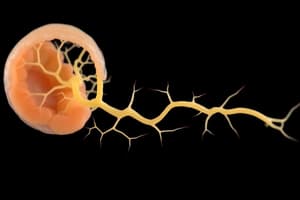Podcast
Questions and Answers
¿Qué tipo de células especializadas dan inicio al desarrollo del sistema nervioso central?
¿Qué tipo de células especializadas dan inicio al desarrollo del sistema nervioso central?
- Células neuroepiteliales (correct)
- Células endodérmicas
- Células ectodérmicas
- Células mesodérmicas
¿Qué estructuras huecas forman los pliegues neurales durante el proceso de embriogénesis del sistema nervioso central?
¿Qué estructuras huecas forman los pliegues neurales durante el proceso de embriogénesis del sistema nervioso central?
- Tubos neurales
- Vescículas neurales (correct)
- Folículos neurales
- Pliegues endodérmicos
¿Qué estructura se forma a partir de la fusión de los pliegues neurales?
¿Qué estructura se forma a partir de la fusión de los pliegues neurales?
- Tubo neural (correct)
- Tallo neural
- Surco neural
- Ventrículo neural
¿En qué parte del tubo neural se desarrolla el cerebro y la médula espinal?
¿En qué parte del tubo neural se desarrolla el cerebro y la médula espinal?
¿Qué estructura forma la corteza cerebral y el diencéfalo en el desarrollo embrionario?
¿Qué estructura forma la corteza cerebral y el diencéfalo en el desarrollo embrionario?
¿Qué zona del tubo neural contiene células madre neurales que generan diferentes clases de neuronas y células gliales a través de divisiones simétricas y asimétricas?
¿Qué zona del tubo neural contiene células madre neurales que generan diferentes clases de neuronas y células gliales a través de divisiones simétricas y asimétricas?
¿Qué se encuentra debajo de la zona ventricular y sirve como fuente de células amplificadoras de tránsito que brindan apoyo adicional a la corteza en desarrollo?
¿Qué se encuentra debajo de la zona ventricular y sirve como fuente de células amplificadoras de tránsito que brindan apoyo adicional a la corteza en desarrollo?
¿Qué proceso guía gradualmente a las neuronas producidas dentro del tubo neural hacia sus destinos finales?
¿Qué proceso guía gradualmente a las neuronas producidas dentro del tubo neural hacia sus destinos finales?
¿Cuál es una de las estructuras específicas que se generan durante la regionalización del tubo neural?
¿Cuál es una de las estructuras específicas que se generan durante la regionalización del tubo neural?
¿Qué revelan los estudios sobre los mecanismos de embriogénesis del Sistema Nervioso Central?
¿Qué revelan los estudios sobre los mecanismos de embriogénesis del Sistema Nervioso Central?
Flashcards are hidden until you start studying
Study Notes
Understanding CNEB: Central Nervous System Embryology Basics
The development of our intricate central nervous system (CNS) is a complex process that begins with specialized cells called neuroepithelial stem cells found within embryonic structures known as neural tubes. This fascinating journey starts very early during fetal life and spans several stages characterized by the growth, differentiation, and organization of nerve cells into a functional brain and spinal cord. Let's explore key aspects of this remarkable biological odyssey, focusing on the Central Nervous System Embryogenesis (CNEB).
Origins of Neural Tissue
In the third week after conception, three distinct germ layers emerge from the inner cell mass within the developing embryo: ectoderm, mesoderm, and endoderm. It is the ectodermal layer that gives rise to all neural tissues via a series of events involving rolling, invagination, and eventually folding processes forming two hollow cylindrical structures called neural folds or neurectoderm. These folds merge together along their dorsal midline, becoming the neural tube. Each side of the neural tube develops into what we now know as the brain and spinal cord, while its roof becomes the cerebrum and diencephalon, and floor forms the medulla oblongata, pons, cerebellum, and spinal cord.
Early Stages and Zones of Neurogenesis
Upon formation, the developing neural tube undergoes rapid diversification, resulting in multiple zones where neuronal proliferation takes place:
- Ventricular zone (VZ): Lining the lumen of the neural tube, it contains neural stem cells generating diverse classes of neurons and glia through symmetric and asymmetric divisions.
- Subventricular zone (SVZ): Situated beneath the ventricular zone near the future mantle layer, the SVZ serves as a source of transit amplifying cells providing additional support to the expanding cortex later in development.
Regionalization and Pattern Formation
As the neural tube elongates, regionalization occurs due to molecular gradients, signaling centers and rhythmic activity patterns. Distinct regions arise based on gene expression profiles and interactions between migrating neurons and supportive glia cells, giving rise to specific structures such as cortical lobes, basal ganglia, thalamus, and hindbrain regions like the cerebellum and reticular formation.
Migration and Organization
Neurons produced within the neural tube gradually move outwards towards their final destinations, guided by various chemotropic factors secreted by the surrounding environment. In addition to radial migration, some neurons also travel tangentially across the surface of the brain. Once situated in their correct location, neurons begin to make connections with other neurons, thereby establishing communication networks essential for proper functioning of the entire system.
Conclusion
Central Nervous System Embryogenesis is an astoundingly complex and delicate process that requires precise timing and coordinated execution of numerous steps. Through studies exploring these mechanisms, scientists have gained valuable insights into normal human development, as well as potential causes underlying certain neurological disorders and birth defects. As science continues to delve deeper into the mysteries shrouding embryological origins and elaborations of the CNS, new discoveries will undoubtedly uncover further ways to enhance our understanding of ourselves and improve our ability to treat diseases affecting the vastly interconnected fabric of the human mind.
Studying That Suits You
Use AI to generate personalized quizzes and flashcards to suit your learning preferences.



